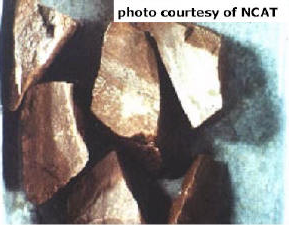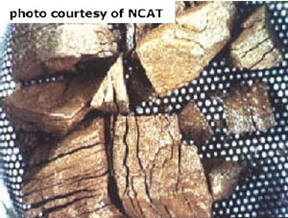Sulfate Soundness Test
The soundness test determines an aggregate’s resistance to disintegration by weathering and, in particular, freeze-thaw cycles.
一、 Description
The most common soundness test involves repeatedly submerging an aggregate sample in a saturated solution of sodium or magnesium sulfate. This process causes salt crystals to form in the aggregate pores, which simulate ice crystal formation (Figures 1 and 2). The basic procedure is as follows (from Roberts et al., 1996[1]):
- 1. Oven dry the sample and separate it into specific sieve sizes.
- 2. Immerse the sample in a saturated solution of sodium or magnesium sulfate and let it remain at a constant temperature for 18 hours.
- 3. Remove the sample from the solution and dry to a constant weight at 110 ± 5oC (230 ± 9oF).
- 4. Repeat this cycle five times.
- 5. Wash the sample to remove the salt; then dry.
- 6. Determine the loss in weight for each specific sieve size and compute a weighted average percent loss for the entire sample.
The maximum loss values typically range from 10 – 20 percent for every
 Figure 1: Aggregates before a soundness test.
Figure 1: Aggregates before a soundness test.
 Figure 2: Aggregates after a soundness test
Figure 2: Aggregates after a soundness test
Other soundness tests use relatively the same procedure but substitute actual freezing and thawing in place of the salt crystallization of the procedure described previously. Cracks in PCC resulting from poor aggregate freeze-thaw resistance are often called durability cracks or “D cracks”.
一、 Standard Test Methods
- ● AASHTO T 104 and ASTM C 88: Soundness of Aggregates by Use of Sodium Sulfate or Magnesium Sulfate
- ● AASHTO T 103: Soundness of Aggregates by Freezing and Thawing – not described here